Why Folder Structure is Important for Documents in Salesforce?
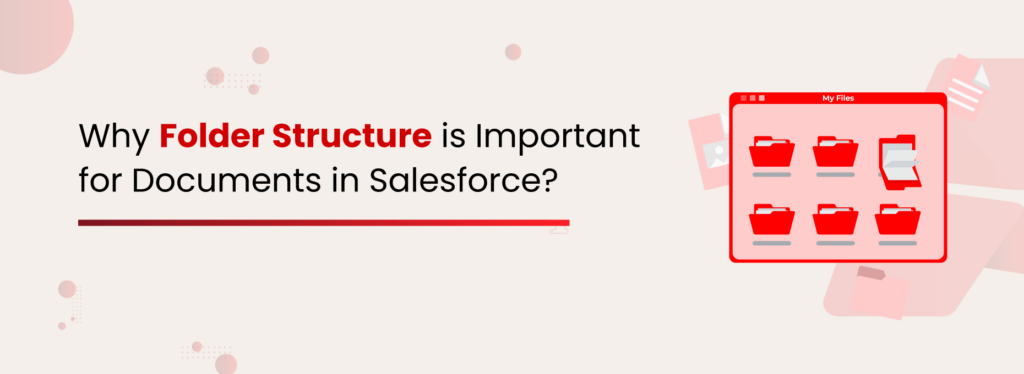
Did you ever feel that your Salesforce is like a messy cabinet with documents scattered all over? Fret no more, you can think about the possibilities of creating folder structures for your Salesforce documents. Having a well-organized folder structure can reduce clutter caused by unorganized documents within Salesforce. And, most importantly, folder structures are an essential aspect of efficient document management so, you need to explore its potential. Let’s look into some of the benefits of creating folder structures to organize documents within the CRM. What is XfilesPro? Ease of Navigation: A folder structure provides a hierarchical document organization that facilitates easy navigation. Users can quickly locate and access the documents under relevant folders. Document Security: If you have sensitive or confidential documents that are meant to be accessed only by some authorized team members but are mixed in all documents, the confidential data will be exposed to unauthorized users. Zero Document Loss Risk: Creating folder structures eliminates the risk of accidentally deleting documents or overlooking important files out of a large volume. Document Collaboration: A well-organized folder structure supports collaboration by unleashing a shared space where team members can access and edit documents, ensuring everyone is contributing to the same set of documents at the same time. Scalability: A scalable folder structure accommodates the growth of your document volume inside Salesforce. As the number of documents mounts up, a well-formulated folder structure ensures that the system remains organized. Workflow Efficiency: A folder structure can align with your workflow, ensuring that documents are leveraged seamlessly through different stages of the process. Version Control: By maintaining clear folders for different versions or stages of a document, users can easily track and work on the most recent version. With all the advantages being said, it’s unfortunate to learn that Salesforce doesn’t offer the functionality to create folder structures within the CRM. So, the question here is how will you create one? XfilesPro: Your Pathway to Organize Salesforce Documents in Folders Let us suggest the most recommended solution to create folder structures in Salesforce — XfilesPro. Before diving into how XfilesPro creates folder structure in Salesforce, let’s take a brief look at its functionality. The most popular document management application for Salesforce, XfilesPro integrates Salesforce with any of your preferred external cloud storage such as SharePoint, AWS S3, Google Drive, and OneDrive. Post integration, the application automatically moves your documents from Salesforce to your external repository so that your storage space will remain optimized. Now let’s come back to the folder structure part. XfilesPro understands that creating a folder structure for Salesforce files and attachments is essential for operational efficiency. Therefore, the app provides functionalities to arrange documents under organized folders inside Salesforce and reflect the same structure in the external storage. How Does This Magic Happen? XfilesPro helps you create a new folder in Salesforce every time a user creates a new record. This folder provides you the free hand to create sub-folders relevant to the specific account, within which you can arrange documents in your preferred folder hierarchy. Having a folder structure in Salesforce, you can allocate specific folders for your individual users/departments/teams in your organization, which helps them access relevant documents quickly and seamlessly. Let us give you more clarity with an example. Imagine, you have onboarded five new customers, which are from five different industries and geographical locations. You can categorize the folders for each of them with the names of their specific industries and geographies and store relevant documents inside them — all while mirroring the same hierarchy in the external storage. That’s how easily the magic works! How Can You Customize the Folder Path? By offering the ability to form folder structures in Salesforce, XfilesPro ultimately aims to empower users to store their documents in their desired format. For that, XfilesPro offers two folder structure options. The first one is Custom Folder Structure. XfilesPro’s Custom Folder Structure allows you to redefine the default folder structure (comes with XfilesPro adoption) Object/Object Name/Record ID to any format that deals with your demand. The next option is Template Folder Structure. Let’s think about your everyday business needs. It’s common that you will encounter requirements where you need to create the same set of folders for every record creation. For example, you may want to create Invoice and Closing Statement folders upon every record creation under the Object Details of Closed Deals. However, it requires repeated manual efforts to build these folders whenever a new record is created under the object. Template Folder Structure eliminates this continuous manual work, by helping you pre-define the folder structure. So, you can have the folders Invoice and Closing Statement automatically created with every record creation under the Details of Closed Deals object. That means you are finally free from that task! We know it’s enough to be happy! You took a quick tour of the enormous possibilities that XfilesPro delivers to accomplish your folder structure requirement in Salesforce. And, you learned that folder structure can help your teammates to access documents easily, which is a green flag for increased productivity. Now what? You would like to see how it works for you! We’re happy to help! Please connect with our experts to see how the folder structure for Salesforce files and attachments can create a wave in your workflow! Transform Folder Structure Creation for Salesforce Documents to an Easy Feat Discover how an Insurance Company Built a Customized Folder Structure to Arrange Salesforce Files in S3 with XfilesPro Read the Case Study Sambitwww.xfilespro.com
7 Reasons Why You Should Store Your Salesforce Files In SharePoint, From An #AwesomeAdmin’s Perspective.
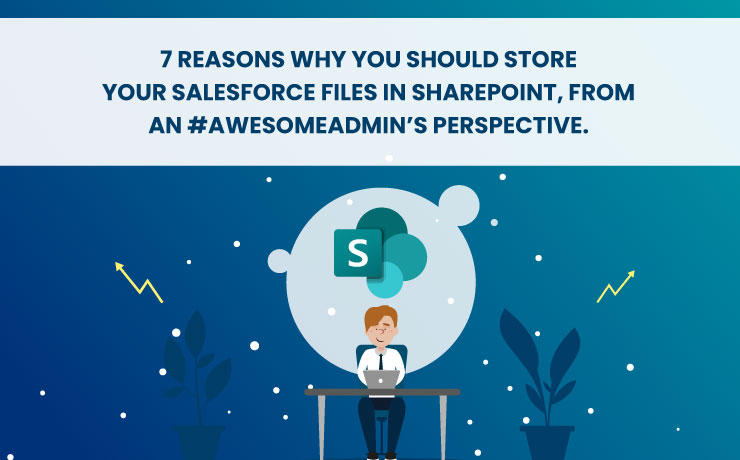
Most Salesforce Admins do not believe when we say that managing documents in Salesforce can be easy and automated. We got them completely as we understand that Salesforce is a bit tricky when it comes to file management. Because the CRM platform comes with limited file storage space, the overgrowth of the files would fail the admins to operate the application effectively. Migrating files from Salesforce to an external storage is its only solution. If you’re already using SharePoint, the popular storage system, don’t look further than it as SharePoint provides a lot of advancements to store your Salesforce files externally. Before discussing those factors, let’s take a brief look at SharePoint. A Little Light on SharePoint SharePoint is a proprietary, web-based collaborative platform that integrates natively with Microsoft 365. It’s one of the most popular document management and storage platforms today with over 100 million users worldwide. SharePoint has been making it easy for customers to set up a centralized, password-protected space for safe and secure document sharing, downloading, editing, and uploading. Now, the point of discussion is on the integration of SharePoint and your Salesforce. As you already know, you need to partner with a solution provider for this. To make your life easier, we’d recommend you use XfilesPro, the #1 file management app for Salesforce.XfilesPro integrates Salesforce with your SharePoint without even the need for an additional connector. And post-integration, the application automatically migrates your files from Salesforce to SharePoint in pre-defined intervals and by following the hierarchy of the files. The best part is that apart from SharePoint, XfilesPro also supports other file storage platforms such as AWS S3, OneDrive, Google Drive, and on-premise platforms. With that note on the functionality of XfilesPro, let’s discuss the seven factors why you need to store your Salesforce files in SharePoint by leveraging the power of XfilesPro. Learn why XfilesPro is the most preferred app to connect Salesforce and SharePoint for file storage here. A Slim Wallet Solution Trust us, purchasing additional storage space from Salesforce might break your bank! When sharing files to SharePoint externally, you are saving a huge amount of money associated with the purchase of extra storage space from Salesforce. In addition, as XfilesPro eliminates the need for an additional connector to integrate both platforms, you’re once again receiving an opportunity to save pennies. A Huge Storage Suite With the SharePoint-Salesforce Integration, the need for your file storage out of the Salesforce environment is satisfied with the huge storage capacity provided by SharePoint. The biggest urge for file storage optimization is met. End-to-end Process Automation With the power of XfilesPro, you can automate your file migration process and eliminate manual efforts behind managing files in SharePoint. At the same time, if you want to opt for the manual workflow, XfilesPro also provides the ability to carry out file management in your preferred way at your convenience. Leveraging SharePoint Tagging In search of the right file, sometimes naming conventions will also not be a best practice in a huge directory of files. But with the feature of SharePoint tagging, XfilesPro allows you to apply metadata labels or tags to documents, list items, and other types of content in SharePoint. These tags can be used to categorize and organize content based on different attributes, such as keywords, topics, or themes. Discover how a two-decade-old IT firm automated the migration of Salesforce Files to SharePoint with XfilesPro. Future-proof Security of Files Firstly, there are certain security measures that SharePoint offers to safeguard your files within its platform. On top of that, XfilesPro delivers security expertise including Access Control and Encryption at Rest that helps you to rest assured that no unauthorized users are accessing your files. Real-time File Collaboration Since your Awesome Admin role has never experienced anything like file collaboration in Salesforce, XfilesPro gives you that golden opportunity to collaborate on files in real-time in SharePoint. This is a great chance to eliminate the endless time required for file modification by several users. Enterprise-level File Management Experience By managing Salesforce files in SharePoint with XfilesPro, you’re stepping into the modern document management world, where automation rules the game and everything is controlled by you. Explore how Salesforce-SharePoint integration helps you transform your Salesforce file storage needs here. Huh… That seems like a lot of reasons to choose SharePoint as a repository of migrated Salesforce files. But the only necessity is XfilesPro! If you wish to learn more about how to use your SharePoint platform to keep your migrated Salesforce files, schedule a demo with one of our product experts. Achieve No-code Integration Between Your Salesforce and SharePoint Discover the easiest way to connect your Salesforce with SharePoint for a Seamless Document Management Experience Download Datasheet Sambitwww.xfilespro.com
How to Enable Real-time Document Collaboration in Salesforce & its Benefits

Years ago, the collaboration on a Salesforce document gave us the sense of a long and intricate process. A document had to be shared from one person to another for contribution, and, it took ages to get the document back to the originator. But now is the age where things happen in real-time. The document collaboration in Salesforce is no different from it. Understanding the evolving demand for streamlined actions on Salesforce documents, XfilesPro offers real-time document collaboration functionality, where both internal and external teams/users can work together on documents. In this article, we will discuss how XfilesPro enables the real-time document collaboration experience in Salesforce and how it helps you drive business more efficiently. Before that, let’s take a glance at XfilesPro. The Most Installed Document Management System for Salesforce XfilesPro understands your pain of upgrading the file storage space consecutively for a certain cost. As you can’t help with the growth of documents inside Salesforce or the storage overloading consequence follows, XfilesPro offers a free hand by freeing up your Salesforce file storage space by migrating documents to external storage. Be it SharePoint, Google Drive, OneDrive, or AWS S3, XfilesPro can move Salesforce documents to your preferred external cloud, helping you optimize the storage space and achieve peace of mind. Now, let’s get back to the document collaboration aspect. How does XfilesPro make this magic work within Salesforce? XfilesPro’s Bi-Sync Functionality: The Magician It’s XfilesPro’s Bi-sync functionality that brings about the magic. With Bi-sync, you can sync your Salesforce records with respective files/folders in the external storage post-migration process. This helps you have the modifications made on the Salesforce records to be reflected in the corresponding documents in the external system, and vice versa, instantaneously. We will make this more clear to you. Imagine the scenario. One of your internal team members is working on a document inside the CRM while an external user also modifies the respective document in the external storage. With Bi-sync, you can have the changes made by both of them to be mirrored in Salesforce documenst and the same on external storage right away, ensuring an effective real-time document collaboration experience. Now that you discovered how real-time document collaboration happens in the CRM, it’s time to look into the benefits that this powerful capability unleashes. Streamlined Workflow Trust us, you will witness a dramatic improvement over how people have managed and modified a document in the past. When the traditional way of document collaboration demands laborious manual tasks and time, a real-time document collaboration experience in Salesforce streamlines the entire process by fastening it up. Here, authorized users can contribute to a document simultaneously, no matter if they are internal or external team members. Learn more about the role of Salesforce document management in streamlining your workflow. 2. Enhanced Productivity The good news is that with real-time document collaboration, your productivity will score the highest. Because you’re eliminating the long hours or even days that are needed for document updation by multiple users. In other words, you’re saying goodbye to the excessive amount of time spent on emailing the documents back and forth, downloading or uploading them, creating multiple versions of those to be shared with others, and so on. So, you can concentrate on your core mission, which boosts productivity. 3. External User Access It’s a big feat to ease the process for external users in order to help them work on your Salesforce document. As we saw above, XfilesPro’s Document Collaboration functionality provides the permission for external users to work on your Salesforce documents along with your internal team members. So, the process becomes streamlined and faster. This is indeed a great step toward ensuring an efficient document collaboration strategy. Discover more about the potential of document collaboration in Salesforce. That’s it. By now, you must have learned why you can’t underestimate the power of real-time document collaboration in Salesforce that XfilesPro built for you. If you think this advancement can level up your document management operations in Salesforce, please connect with us to learn more. Sambitwww.xfilespro.com
XfilesPro’s List Component: Making File Management in Salesforce Easy & Better
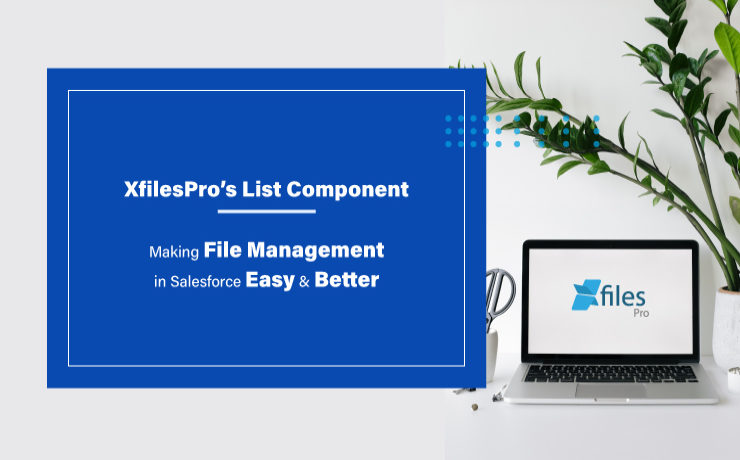
Our application, XfilesPro, was launched back in 2013 to help Salesforce customers around the globe easily manage the innumerable amount of files & attachments in their Salesforce Org. Following that, we have constantly released subsequent versions of the application where new features and capabilities have been added to improve the overall experience. To define XfilesPro, it is an advanced file management & external storage collaboration solution for Salesforce which makes managing files in Salesforce extremely hassle-free. Being one of the top AppExchange applications for file management, it lets enterprises seamlessly store and collaborate their Salesforce files/attachments with various external storage solutions such as SharePoint, OneDrive, Google Drive, Amazon S3, DropBox as well as in different on-premise storages. Using XfilesPro, Salesforce customers can not only reduce their file storage costs significantly (by nearly up to 70%), but also seamlessly enable a 360-degree file collaboration, involving integration with various external storage systems. Not only this, our highly-customizable application performs exceptionally well with Service Cloud, Sales Cloud, Experience/Community Cloud, Salesforce Platform, and other custom made solutions built on the Force.com platform. Recommended reading: XfilesPro V6.0: Assess & evaluate all that’s brand new This article is intended to make Salesforce users aware of the unique List component of XfilesPro. XfilesPro’s List component is a kind of related list component that can be added to the record layout and acts as an alternative to standard Salesforce Attachments/Files related list. The List component console ‘lists’ down the names and certain details of each file that is moved to the integrated external storage, while offering an option to preview those migrated files from within the Salesforce UI. One of the primary benefits is that when making use of the List component, the Salesforce files uploaded are directly moved to the respective external storage without consuming any of the internal Salesforce file storage. Below mentioned are some of the other prominent features of the List component of the XfilesPro application: File Uploading Functionalities : Point & Click Upload When using the List component, XfilesPro offers simple point & click functionalities to its users which allows them to simply select their desired file/attachment and then click on the button for their desired action: upload, delete, download, etc. They work well for both single as well as multiple Salesforce files at once. Drag and Drop Upload Another way of uploading Salesforce files/attachments in the List component of XfilesPro is by directly selecting the file and then dragging & dropping it to be uploaded. Mass Upload Lastly, when using XfilesPro’s List component, the users also get the option to upload multiple files/attachments at once in a single click. Here it is important to remind that there are still some file upload size limit in different external storages. Note: After uploading files in the List component, they will still be accessible from the component. However, they will actually reside in integrated external storage. Mass File Functionalities : Mass Download Using the mass download functionality of XfilesPro in the List component, the users will be able to select multiple files & attachments at once and then download them by clicking on the download button. Following this, these files will be downloaded in the form of a zip file. Mass Share XfilesPro’s List component also allows Salesforce users to select multiple files/attachments to be shared within the system or with someone outside of the Salesforce system. For this users simply have to select their desired files, then click on the share button and the files will be shared in the form of an email. Mass Delete Another exciting feature of XfilesPro’s List component is its functionality to mass delete multiple files and attachments in a single click. Users have to just select those specific Salesforce files and then click on the delete button after which the files will be permanently deleted from the system. Manage Columns Using the List component of XfilesPro, it’s extremely easy to include and manage additional columns on the component. The users simply have to decide and select the columns that they want to add to the component and then click on the apply button, after which the columns can be seen on the List component. Add Notes When using the List component of XfilesPro, adding special notes to the Salesforce files and attachments is not only possible but also very easy. For this, users just have to click on the ‘Add Note’ button, following which they can add whatever text they want to put as the description for that specific file. That note will be then added to the Salesforce file as its metadata. Download & Delete Even downloading or deleting specific Salesforce files and attachments is straightforward and trouble-free when using XfilesPro’s List component. To do this, users simply have to select that specific file and click on the button for their desired action, after which that file will either be downloaded from the console or be deleted permanently. We hope this article helped you understand the List component as well as its various functionalities in a better manner. In case you still have any questions or doubts, we’ll be happy to resolve them for you. Please get in touch with us or simply schedule a quick live demo here to see everything for yourself. Sambitwww.xfilespro.com
Integrating Salesforce with Amazon S3 for External File Storage: All You Need to Know
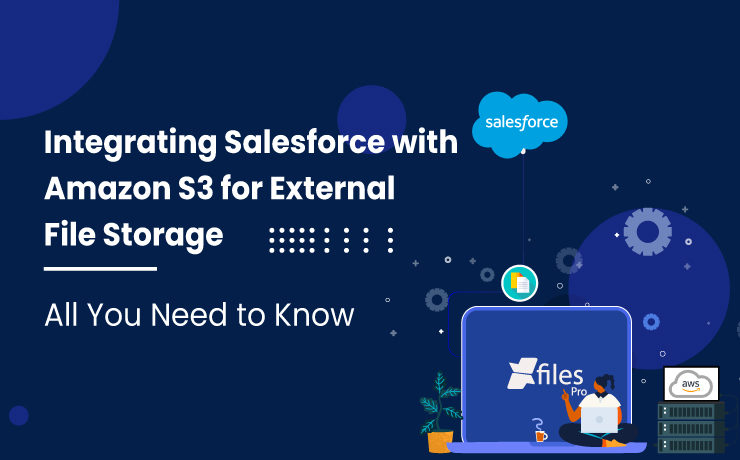
Business success largely depends on connecting with potential customers in a meaningful way & also through the platforms that they choose. Salesforce as a CRM has been allowing businesses to achieve the same & also consistently. With its world-class products, Salesforce has been pivotal in many company’s sales, marketing, and customer service success for the past several years. Organizations are leveraging Salesforce’s Customer 360 platform to obtain better business visibility, minimize sales cycles, deliver improved customer service, and make informed business decisions. On the flip side of the coin, while allowing customers to accelerate their success on its CRM platform, Salesforce has also set certain restrictions in order to maintain the high performance and consistency of its premium applications. Primary application storage limit is definitely one such limitation, and businesses often find it difficult to address. Storage upgrades come at a high price & purchasing additional storage space from Salesforce is always a tricky decision to make. Integrating Amazon S3 with Salesforce for Storage Collaboration Organizations that are joint customers of Salesforce & Amazon, always have the option to extend their Salesforce file storage by connecting the CRM platform with their Amazon S3 system. With this, Salesforce files can be seamlessly moved and stored in relatively less-priced S3 storage for a long period of time. This cross-platform integration is extremely effective in resolving challenges related to Salesforce file management including limited storage, easy collaboration, unlimited sharing, and dealing with large file sizes. On the other hand, Amazon offers S3 storage as one of the most popular object storage services that ensures industry-leading scalability, information availability, security, & performance to its users. In addition to the above features, S3 also offers a simple interface and robust document management capabilities including collaboration, sharing, and access. Why choose S3 for Salesforce file storage? Some of the primary reasons to choose S3 for Salesforce file storage are: Lower Investment In contrast to adding more storage space at the expense of additional cost, or increasing the number of Salesforce licenses, enterprises can simply leverage their S3 storage to offload Salesforce files. This will also make collaboration easy among large teams & reduce the overall costs. Store Large Documents As Salesforce restricts the upload of large-size files to its CRM, S3 can make it possible & allows organizations to manage large files with ease. Businesses can ensure seamless business operations every time & this will also enhance productivity. Quick Inter-entity Linking Quick linking is another beneficial feature of S3 to Salesforce integration. It allows users to link specific documents with other business entities, like marketing campaigns, opportunities, quotes, sales documents, and case studies, from right inside the system. By integrating, users can also edit, retrieve, and share documents from within the Salesforce UI itself. Folder Structures With S3, Salesforce users can also keep their files in a highly structured way within multiple folders. They can also create sub-folders, & custom structures to fit their business needs. Also Read: Salesforce File Management: Storage & External Collaboration (A Complete Guide. XfilesPro Enabling Salesforce – Amazon S3 Integration Instead of performing the complex integration between Salesforce & AWS S3 themselves, most Salesforce customers look for other solutions that can streamline the integration processes. These include the native Salesforce Files Connect framework, simple custom-built integration applications, & different ready-made 3rd-party applications. One of the best places to look for third-party solutions is the Salesforce AppExchange. Here is where admins will come across our advanced Salesforce file management & external storage collaboration application, XfilesPro. Learn more: Effortlessly Store Salesforce Files In S3 With XfilesPro: A Step-By-Step Guide XfilesPro helps enterprises seamlessly store & collaborate their Salesforce files with AWS S3, owing to its powerful integration capabilities. This highly popular application can enable a 360-degree collaboration between the systems and help enterprises resolve their Salesforce file management issues. XfilesPro’s other features like folder structure, bi-directional sync of files, large-volume file export, folder syncing, file sharing, community user file management, and much more make the app #1 in its segment & a must-have Salesforce admin application. Using XfilesPro, Salesforce users can also cut back on their file storage costs significantly & do away with the need to purchase any additional file storage space from Salesforce. In addition to AWS S3, users can also use XfilesPro to integrate their Salesforce CRM with various other external file storage systems like OneDrive, SharePoint, Google Drive, and on-premise platforms. Learn more: How To Store Salesforce Files In Amazon S3 Using XfilesPro: A Comprehensive Guide Looking for Salesforce AWS integration to store Salesforce files in S3 storage? Please request a XfilesPro demo. Sambitwww.xfilespro.com
Understanding Salesforce File Storage Limitations
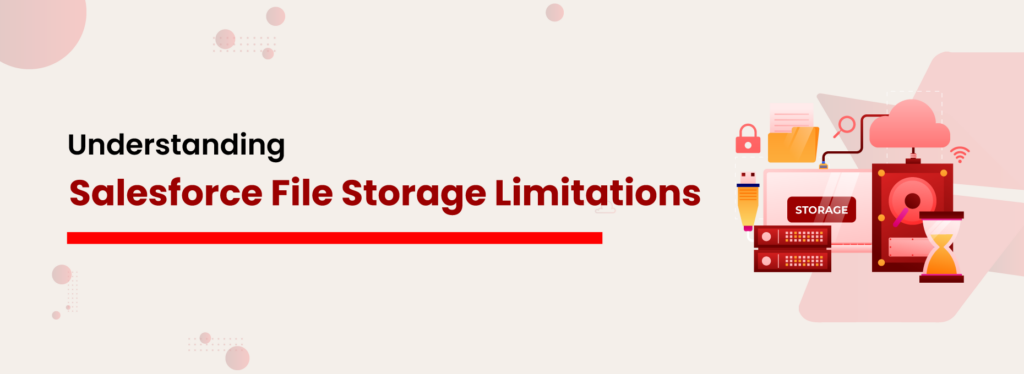
Over the last two decades, Salesforce has emerged as the #1 CRM provider in the world. Thousands of businesses from different verticals & sizes are relying on the massively popular Salesforce applications to boost their sales & service processes and also trusting its robust platform to build powerful business applications. Though Salesforce offers a multitude of benefits in order to ensure consistent & hassle-free performance every time, the CRM giant also limits some of its functionalities in order to maintain its high performance & consistency. One such notable limitation is storage. Please note that any Salesforce org has three default storage spaces including files, data, and big objects. In this blog, we are going to focus on Salesforce file storage & will discuss some of the Salesforce file storage limitations. Whenever a user uploads/generates/receives files (commonly notes & email attachments) of any type while using Salesforce, they get stored in a primary repository within the app. This applies to any standard user as well as a community user. How much file storage space do you have in your Salesforce org? When it comes to default file storage; Salesforce editions such as Contact Manager, Group, Professional, Enterprise, Performance & Unlimited get 10 GB space per org, while the Essentials edition gets only 1 GB. In addition to this, every Salesforce org offers some additional file storage space to standard users depending on the edition and the number of user licenses. Enterprise, Performance, & Unlimited editions get an additional 2 GB of file storage per user license, while Contact Manager, Group, & Professional editions get 612 MB per user license. What is the maximum size of file that you can upload in Salesforce? Salesforce doesn’t only have limited offered storage space, it also limits the file size when it comes to storing it within the app. Below are the file size limits; Salesforce Files (Files home, in libraries, in Chatter posts and comments, on a record’s Files related list): 2 GB Attachments (On a record’s related list in Lightning Experience. (In Lightning Experience, attachments are added as Salesforce files): 2 GB Documents, Salesforce Knowledge Attachments & Chat: 5 MB Each Please get more details
Top 3 Ways to Prevent Hitting the Salesforce Storage Limit in your Org

In order to keep up with the changing industry trends and evolving customer demands, businesses have to rapidly keep on upgrading & reinventing themselves. They need to offer top-notch services and deliver exceptional experiences to their customers so as to always maintain an edge over their competitors. One of the smartest ways to do this is by investing in tools & technologies that guarantee accelerated growth and higher profit, all the while keeping the expenses in check. Salesforce is one of the best technology platforms that offers a powerful CRM system to transform sales, marketing, and customer service departments across industries. This powers enterprises to drive innovation, customer success, and revenue. Being a multi-tenant platform, Salesforce always focuses on maintaining top-gear performances of its applications, and in order to achieve this, it has imposed certain limitations. One such limitation is ‘storage’. Know Your Salesforce Storage Being a leading CRM, Salesforce offers some storage space within its applications/org. Customer’s data & files that are being generated while using the Salesforce app get stored in the allocated Salesforce storage space. Salesforce offers three different categories of storage in every org. Let’s have a look at those. Data Storage: Salesforce data storage is the home for various data records such as accounts, cases, leads, campaigns, contacts, opportunities, email messages, events, orders, tasks, etc. stored in standard and custom objects. File Storage: Salesforce file storage keeps files from notes & attachments, files home, CRM content, Chatter (including user photos), documents, and site.com assets. Big Objects: Salesforce Big Objects is the big data-based storage option that is designed to easily hold voluminous amounts of business data. How Much Storage Space Do You Get in Salesforce? Data Storage Space: If you are using Unlimited, Performance, Enterprise, or Professional editions of Salesforce, you will get 10 GB of default data storage space in the org along with 20 MB of additional data storage for each user license. For example, a Professional edition org with 20 users, will receive 10 GB of data storage, plus 20 MB per user which is 400 MB for 20 users. This makes the total data storage 10.4 GB for the company. File Storage Space: Similarly all the above Salesforce editions receive 10 GB of file storage space and an additional 20 MB of storage per user license. Salesforce Essentials edition gets 1 GB of file storage space per org. Only the Professional edition has an additional 612 MB (100 MB per user license + 512 MB per license for the Salesforce Content feature license). Big Objects: When it comes to Big Objects storage, all the Salesforce editions have allocated storage for 1 million Big Object records per Salesforce Org. Is the Allocated Storage Sufficient in Salesforce? Though it largely depends on the usage, in today’s world of data-driven business where enterprises extensively leverage data, the sources of data or file generation have increased. Along with this, the speed of data/file generation has also grown. Considering this, 10 GB of storage is very little for any company. This becomes challenging for businesses that deal with a large number of files, large-size files, more email attachments, and data records. As per industry trends, companies often run out of their allocated Salesforce data and file storage within a span of 2-3 years even with moderate data/file generation. This could be even lower for businesses that generate more data. What Happens When Your Salesforce Storage Starts Filling Fast? When your Salesforce storage starts filling fast, there are several consequences. A few common challenges are: The CRM will become bulky. This will impact the app’s performance, user experience & efficiency. Meeting regulatory compliance & other data policies becomes tough as storing all the business data within limited storage gets complicated. File visibility and accessibility are significantly impacted when seamless collaboration among the users becomes nearly impossible. Storage upgrades in Salesforce are incredibly expensive. Both additional data and file storage space come at a higher cost which might impact the overall budget. How to Increase Your Salesforce Storage Space? After working with multiple Salesforce customers from diverse industries over a decade, we understood what type of methods most enterprises adopt to better manage their Salesforce storage spaces. Here we have made a consolidated list of the means through which the above-mentioned challenges can be combated and the Salesforce storages can be optimized to a greater potential. Option 1: Cleaning up Unused Data Manually or Automatically One of the easiest ways to prevent exceeding the Salesforce storage limits is by purging unnecessary files and data records, either manually or automatically. There are a lot of tools available for these purposes: Salesforce’s Mass Delete Wizard: Salesforce’s web-based native mass deletion wizard allows users to delete record types such as cases, solutions, accounts, contacts, leads, products, and activities. Currently, the complete Mass Delete is limited to around 250 records at once and is also limited to the above-named objects. Extract Transform Loading (ETL) Tools: Certain ETL tools are used for both data migration and data removal. Popular ETL tools like Salesforce Data Loader can be used to delete both data records and files from the system. Other popular ETL tools include Dataloader.io, Informatica, JitterBit, Integrate.io, etc. Most of these tools are paid for and will always require significant investment and evaluation to ensure they meet the requirements. Automatic Deletion: If you don’t want to spend a lot of time and money on removing redundant files and data, several third-party AppExchange applications can be used to automate these tasks. Such applications can easily delete unnecessary files and data from the system, saving both time & manual effort. Option 2: Purchasing Additional Storage from Salesforce If your enterprise is not at the liberty of deleting files, attachments, and data records because of long-term retention guidelines, then you can always opt for purchasing additional file or data storage space from Salesforce. But the thing to keep in mind before going for this option is that additional storage, both file & data, is extremely

